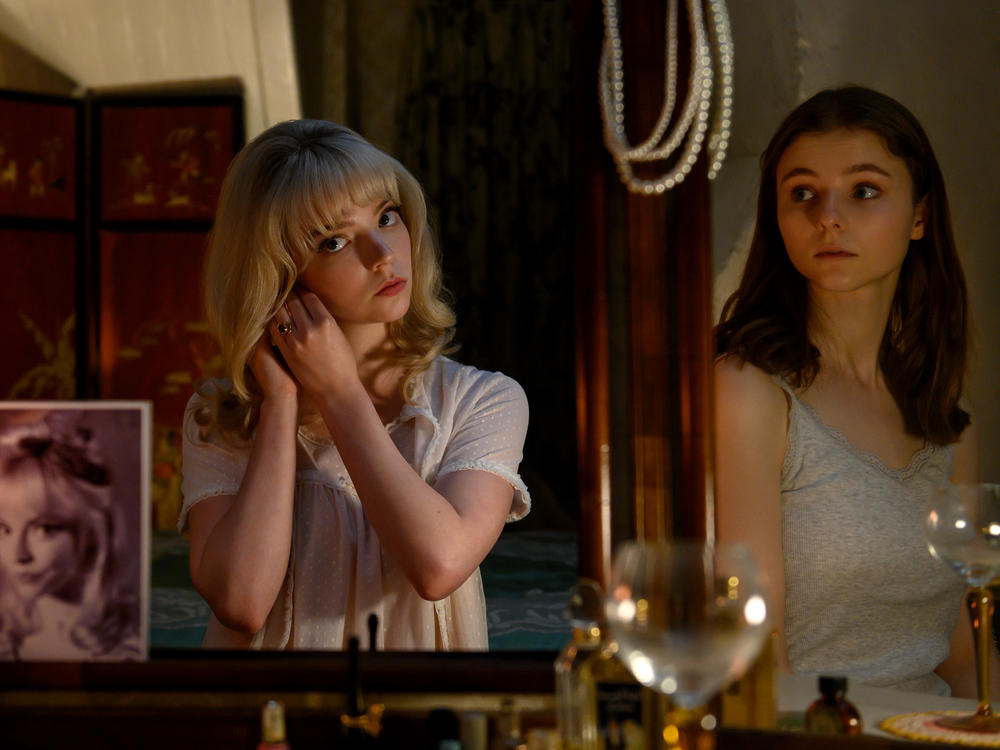Section Branding
Header Content
In 'Last Night In Soho,' Edgar Wright Goes Wrong
Primary Content
Edgar Wright set out to make a trippy fever-dream of a movie. Last Night in Soho, the film he has made instead, is merely febrile: insistent, overworked, maddeningly repetitive and — like the most intense fevers — by turns sweaty and chilly, and keenly unpleasant to experience.
His technical skills remain on full display, however, as he and his team painstakingly recreate the riot of colors, sounds and textures of '60s London, dutifully reproduce the look and feel of giallo filmmaking, and confidently pull off the illusion essential to the film's self-consciously contrived premise.
In the present day, a naïve and sweet small-town girl named Eloise (Thomasin McKenzie), who is obsessed with the Swingin' London scene of the 1960s, gets into the fashion school of her dreams, located in Soho. But she soon becomes disillusioned, and moves out of the student housing where her sensitive nature is preyed upon by Mean Girls and Drunk Boys. She finds a flat steeped in a strange history involving the glamorous, groovy and ambitious young nightclub singer Sandie (Anya Taylor-Joy). Each night, in her dreams, Eloise travels back in time to the 1960s where she sometimes observes and sometimes inhabits Sandie, as the young woman gets drawn into seedy, exploitative relationships with a series of men, including her manager Jack (Matt Smith).
As noted, Wright is a deft hand at staging the clever cinematic effect of Eloise and Sandie trading places, employing both in-camera techniques and CGI to make each switch seem seamless and literally magical. The reason Last Night in Soho feels as leaden and thuddingly repetitious as it does has nothing to do with the movement of his camera, which is less given to the showy quick-cuts and whip-pans that marked his earlier films.
No, the film fails because its every character beat, plot point and narrative turn is telegraphed ten minutes before it occurs onscreen — whereupon it proceeds to get underlined, boldfaced, all-capped and circled. Long scenes of dialogue simply state and re-state (and on more than one occasion, re-re-state) events we have just witnessed. A chase scene through the streets of London goes on forever, and its action only endlessly iterates, never escalates. (At one point late in the film, Eloise stumbles upon a police station and decides to tell authorities of the uncanny events that have befallen her, at which point this reviewer heard an exasperated sigh escape his lips, because I knew exactly — far too exactly — how the next five minutes of the film would play out. If it surprises you, reader, to learn that the cops do not believe her tales of time travel, congratulations: You are the person for whom that wildly unnecessary scene was written and filmed.)
A groovy tune played at earsplitting volume, on repeat
It doesn't help that McKenzie — an actor who's done understated, nuanced work in films like Leave No Trace and Jojo Rabbit -- is directed to vibrate at such a consistently high frequency throughout the film. When we meet Eloise, she is cartoonishly sweet, wide-eyed and naïve. Later, her experiences at fashion school leave her cartoonishly anguished. Later still, the events she witnesses in her travels through time cause her to spend the rest of the film cartoonishly terrified, perpetually on the verge of tears. This choice leaves the character no place to go, emotionally, with no arc to follow — she starts the film at 11, and stays there until the credits roll.
Maybe the idea was for Eloise's status as a raw, exposed nerve to make her seem vulnerable to us, and thus sympathetic. But in execution, because the film is having way too much glib fun casting her as a victim, the character only frustrates. She turns down generous offers of help too many times for it to make any kind of dramatic sense, something the script — by Wright and Krysty Wilson-Cairns — thinks it can justify by attempting to raise the prospect of mental illness in a clumsy, half-assed manner that only succeeds in coming off as cheap, lazy and tone-deaf.
There is a kernel of a promising idea, beneath all this belabored self-indulgence. The notion of having one's simplistic, well-scrubbed ideas about the past challenged by harsh reality could make for film that has something to say about how we make, preserve and confront history — the lies we tell ourselves about ourselves. But the movie is so heavy-handed and self-satisfied that it delights in punishing Eloise for the crime of — what, exactly? Nostalgia itself? Turning her back on her perfectly repellent, deeply toxic schoolmates, whom she has every right to wish to avoid?
Which gets to the real issue — the movie's hopelessly muddled sense of purpose. It's an eager riff on the leering sex and violence of the giallo subgenre, yet it strives to position itself as a kind of feminist fable. That's why it plays at such a uniformly broad, high-pitched emotional volume, and why it spends so much time lingering over the abuse and exploitation of Sandie and other women in such an excessive, repetitive and gleefully lurid manner. As a result, it ends up ogling the violence against women that it purports to hold at arms' length.
This is all the more mystifying, given that each of Wright's previous films is possessed of a certain indefatigable lightness, a nimble quality to the storytelling that has nothing to do how fast he moves his camera, and everything to do with the twinkling, knowing sense of playfulness they exude. Last Night in Soho, on the other hand, is a loud, depressing and irritatingly manipulative two-hour wallow.
Copyright 2021 NPR. To see more, visit https://www.npr.org.

